Posterior Tibial Tendon Dysfunction (PTTD) additionally referred to as posterior tibial tendonitis, is one of the most common issues of the foot and ankle. It happens when the posterior tibial tendon becomes inflamed or torn. As a result, the tendon may not give stability and support for the arch of the foot, leading to flatfoot. It is a debilitating condition if untreated. Most patients are treated effectively without surgery, by using orthotics, posterior tibial tendonitis brace, and posterior tibial tendonitis exercises.
If orthotics and ankle braces don’t give relief, surgery will be an effective way to ease the pain. Surgery can be as simple as removing inflamed tissue or repairing a simple tear. However, many patients can notice some limitations after surgery.
Posterior Tibial Tendon Anatomy
The posterior tibial tendon is one of the foremost vital tendons of the leg. A tendon attaches muscles to bones, and therefore the posterior tibial tendon attaches the calf muscle to the bones within the foot. The major function of the tendon is to keep up the arch and support the foot when walking.
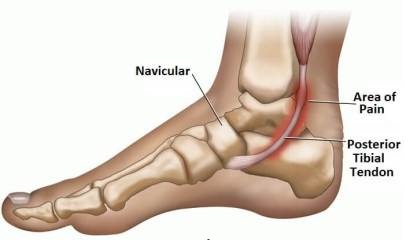
What Happens if Untreated Posterior Tibial Tendonitis?
PTTD is typically a progressive condition, so it’ll usually deteriorate if left untreated and unsupported. Once left untreated, the arch can flatten more, and the foot and arch can turn outward because the ankle rolls inward. After this, the tendon can continue to deteriorate, resulting in arthritis, more pain, and a heavily disrupted walking pattern.
Best Posterior Tibial Tendonitis Ankle Brace
Luckily, ankle braces and taping effectively treat PTTD for many cases if it treats the condition at an early enough stage. A PTTD brace can help support the foot’s arch, accounting for various arch shapes and heights to form positive the condition does not develop any longer, and your pain regresses. With the utilization of a PTTD ankle brace, your walking pattern can normalize, and also, the symptoms of posterior tibial tendonitis will diminish.
Aircast AirLift PTTD Brace
They design the Aircast AirLift PTTD Ankle Support Brace to treat Posterior tibial tendon dysfunction (PTTD), or early signs and symptoms of the adult acquired flatfoot. Depending on the severity of your condition, you’ll be able to use it as a part of a conservative treatment to stabilize and help to forestall degeneration or post-surgically and through rehabilitation.
This ankle support brace is formed of latex-free neoprene and is intended for easy application and adjustment. The innovative rear entry style permits you to slip your foot into the back of the brace. You’ll be able to merely adjust the two Velcro straps to secure the brace which eliminates time-consuming lacing.
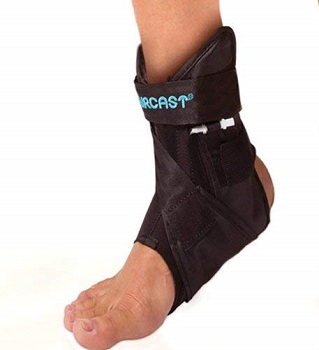

The Aircast AirLift PTTD accommodates variances in arch shapes and heights to elevate the foot arch to a more natural foot position. It’s tested the air cell with 2,000 lbs. of pressure to resist the force from running, jumping, and landing, and different high-impact activities. The inflation air sac located underneath the foot will be adjusted whereas worn with the enclosed hand bulb air pump. We suggest wearing this brace with an athletic or walking shoe as the brace is also slightly bulky.
- Accommodates variances in arch shapes and heights to elevate the foot arch to a more natural foot position
- Designed for simple application and adjustments
- Made from the latex-free synthetic rubber material
- Slightly bulky
Bioskin TriLok Ankle Brace
The TriLok is a versatile brace that gives protection, support, and pain relief from multiple feet and ankle injuries. The compression of BioSkin TriLok ankle brace enhances your body’s circulatory system. Blood flow is enhanced and unwanted fluid is removed more with efficiency due to the external pressure provided by compression.
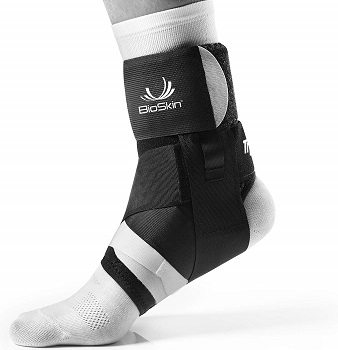

The TriLok offers an innovative approach to relieving pain related to posterior tibial tendon dysfunction, or PTTD. The key to the TriLok’s effectiveness is the patented, white FootLok Strap. This strap mimics the posterior tibialis, the muscle/tendon structure accountable for lifting the foot’s arch. Once the posterior tibialis becomes weak or damaged, it loses its ability to lift the arch properly. The TriLok’s FootLok strap elevates the arch and eases pain by correcting overpronation and restoring the foot to its natural position.
- Sensiblesupport and comfy
- Breathable design
- Soft protecting layer
- It will use on either foot with a slight adjustment
- Simple and adjustable tension on the TriLok strap
- Little bit expensive
- Might stretch shoes out of shape
BraceAbility Rigid Hinged Ankle Stabilizer
The Rigid Ankle Support by BraceAbility features a non-bulky, semi-rigid shell on your ankle and bilateral hinges to assist forestall further injury and shield against inversion and eversion movements whereas permitting normal ankle function. The Hinged ankle brace is specifically designed to provide light ankle immobilization and protection from a ligament injury, posterior tibial tendon dysfunction (PTTD), sprains, rolls, and instabilities.
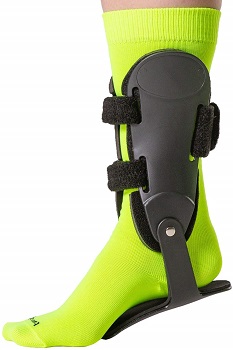
This brace offers the most support and protection, withstanding the impacts and demands of competitive play; Thus, you’ll be able to play without worrying about re-injury. It has an Open-heel style that prevents pinching and discomfort usually associated with closed-heel ankle braces and lace-up ankle guards.
- Premium grade synthetic rubber cushioning
- Bi-lateral hinges
- Non-bulky form of ankle brace
- Sizes are smaller
MedSpec Supinator PTT Stabilizer Brace
The Medspec supinator PTT Stabilizer is a comfy and comparatively low-profile brace to treat posterior tibial tendon dysfunction (PTTD). The supinator reduces over-pronation by applying a supinating force to alleviate posterior tibial tendon dysfunction.
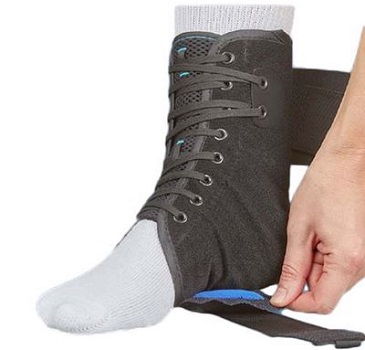
The arch strap works together with a repositionable arch pad to elevate the medial arch. The arch pad might also be removed if desired and to permit the supinator to be worn with an orthotic. The heel strap restricts the eversion of the calcaneus (heel).
- Arch Strap & Pad works in concert to elevate the medial arch.
- The arch pad might also be removed if desired and to permit the supinator to be worn with an orthotic.
- Heel Strap restricts eversion of the os (heel).
- Each brace is sold individually.
- Machine washes mild cycle, no bleach, air dry
- Easy to use
- Bit high-priced
Recommended Post
- Top Rated ASO Ankle Brace for Ankle Support
- Best Ankle Brace for Achilles Tendonitis Support
- Top-Rated Aircast Airsport Ankle Brace Reviews
- iWALK2.0 – Hands-Free Crutch Reviews
Posterior Tibial Tendonitis Treatment (Conservative)
You can treat minor injuries with the RICE technique at home. Exercise is an efficient way to treat Posterior Tibial Tendonitis. These exercises are designed to stabilize your ankle and foot, removing the posterior tibialis tendon’s stress and strain. The exercises facilitate flexibility, balance, strength, and ankle range of motion (ROM).
Posterior Tibial Tendonitis Exercises
Calf Stretching: 3×30 seconds, each with a straight knee and bent knee, on both legs, twice per day.

Ball Roll Exercises: Rolling a golf or tennis ball under the feet can help to relieve discomfort in the arches and ease pain associated with plantar fasciitis, once per day.
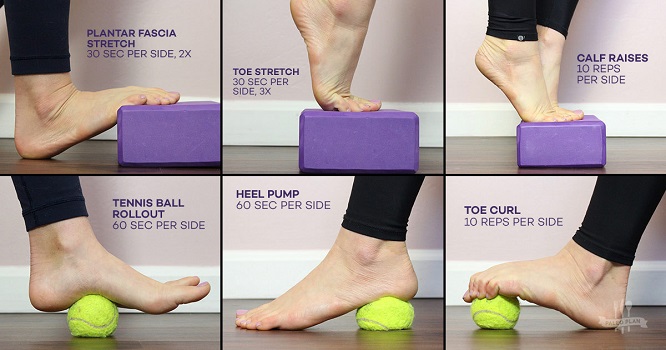
Theraband Exercises
- Dorsiflexion
- Inversion
- Eversion
- Inversion
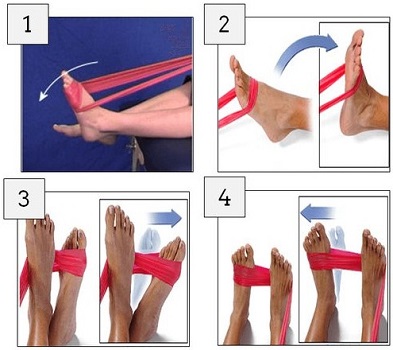
3 sets of 15 repeats with as much resistance as you’ll be able to tolerate. Try this twice per day and increase resistance. Use a towel to decrease friction beneath your foot, once a day.
Functional Exercises
- Single leg heel raise, increase bit by bit to 50 repeats, once a day.
- Toe walking, beginning at 8-10 yards and increasing to 100 yards of continuous toe walking, once a day.

Ice can manage your pain, particularly when doing all your rehab exercises. You can try for 10 minutes of ice massage with an ice cup, followed by a 10-minute rest, and at last another 10 minutes of icing. You’ll ice as often as every six hours.
Wear supportive shoes and orthotics all the time, even once you’re simply walking around the house. Speak along with your doctor or podiatrist concerning whether you’ll use a rigid over-the-counter orthotic or if you need a customized orthotic.
